YAMAHA Low cost high performance SCARA Robot YK-XE Alternatives & Competitors
Ranked Nr. 1 of 164 SCARA Robots
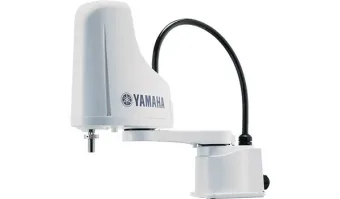
Top 10 Low cost high performance SCARA Robot YK-XE Alternatives
- YAMAHA Small type SCARA robots YK-XG
- YAMAHA Large type SCARA robots YK-XG
- YAMAHA Tiny SCARA robots - Extra small
- YAMAHA Orbit type YK350TW/YK500TW
- YAMAHA Medium type SCARA robots YK-XG
- YAMAHA Wall-mount and inverse type SCARA robots
- Epson G3 SCARA Robots - 350mm
- Epson G6 SCARA Robots - 650mm
- Epson G20 SCARA Robots - 1000mm
- Epson G20 SCARA Robots - 850mm
- Epson G10 SCARA Robots - 850mm

YAMAHA Small type SCARA robots YK-XG
Reach 250-400 mm | Payload 5kgFEATURES:
01. Internal structure achieving the high-rigidity and high-accuracy.
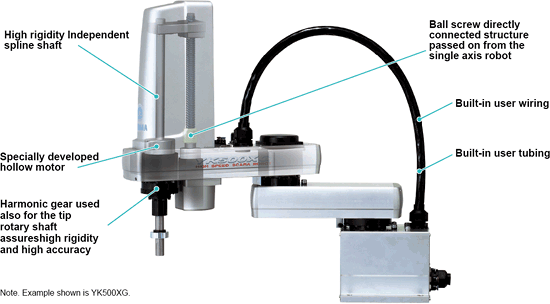
02. Completely beltless structure
A totally beltless structure was achieved by using a ZR axis direct coupling structure. This direct drive structure drastically reduces wasted motion. It also maintains high accuracy over a long period of time. It ensure maintenance-free usage for extended periods with no worries about belt breakage, stretching or deterioration with age (feature applies to all XG series models and the YK180X/YK220X).
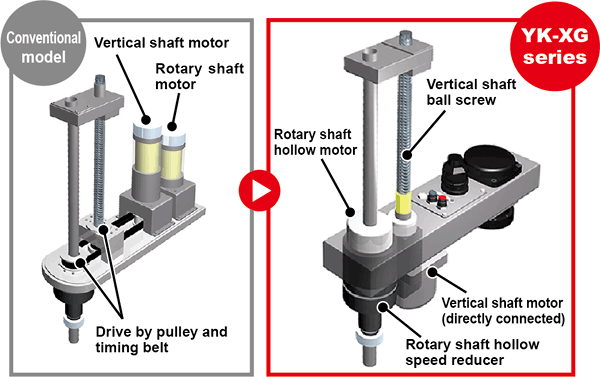
03. High Speed
The standard cycle time is fast of course but the YAMAHA design also stresses tact time in the actual usage region. A drastic improvement in maximum speed was made by changing the gear ratio and maximum motor rpm. This also resulted in a better tact time during long distance movement.

04. Improved maintenance features
The covers on the YAMAHA SCARA robot YK-XG series can be removed from the front or upwards. The cover is separate from the cable so maintenance tasks are easy.
On ordinary robots replacing the grease on the harmonic gear takes a great deal of time and trouble because the gear must be disassembled and position deviations might occur. On YAMAHA SCARA robots however the harmonic gear is the grease-sealed type so no grease replacement is needed (YK-500XG to YK1000XG).
05. Robot R axis inertia moment capacity
SCARA robot performance is not limited to just standard cycle time. Actual work situations include a diverse range of heavy work pieces as well as work with large offsets. Using a low R axis inertia moment in those cases will help drastically cut the cycle time. All YAMAHA SCARA robots have a speed reducer directly coupled to the tip of the rotating axis. The R axis produces an extremely high allowable inertia moment which delivers high speed operation compared to structures where positioning is usually done by a belt after decelerating.

R axis allowable inertia moment : Comparing YK120XG with competitor's models
A large inertia is generated when the offset from the R axis to the load center is large and this can severely restrict the acceleration during operation.
The allowable inertia moment on the YAMAHA XG series is exceedingly large compared to other company SCARA robots in the same class and so can operate at high speed even with a work offset.
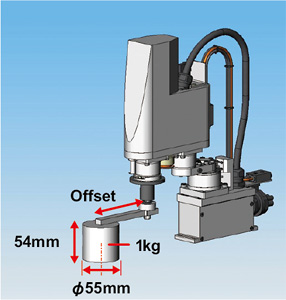
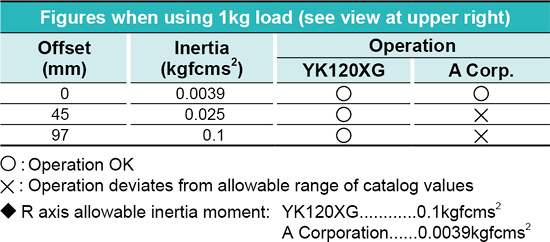
06. Compact
Changing the cable layout made the overall cable height lower than the unit cover.
Also, utilizing a motor with a small overall length and extrusion material base yielded the smallest dimensions among equipment in the same class.
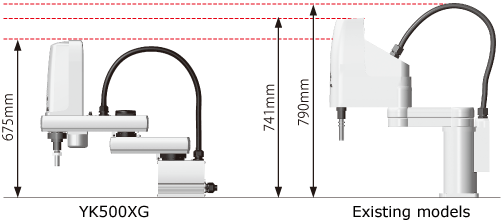
07. Environmentally rugged resolver provides closed loop control
The position detector is a resolver. The resolver has a simple yet strong structure using not electronic components or elements and so has great features such as being extremely tough in harsh environments as well as a low breakdown rate. The resolver structure has none of the detection problems that occur in other detectors such as optical encoders whose electronic components breakdown or suffer from moisture or oil that sticks to the disk. Moreover, mechanical specifications for both absolute and incremental specifications are common to all controllers so one can switch to either absolute or incremental specifications just by setting a parameter.
Also even if the absolute battery is completely worn down, the SCARA can operate on incremental specifications so in the unlikely event of trouble one can feel secure knowing that there will be no need to stop the production line. The backup circuit has been completely renovated and now has a backup period extending to 1 year.
Note. The resolver has a simple structure not using electronic components at all. It is highly resistant to low and high temperatures, impacts, electrical noise, dust particles, oil, etc. and is used in automobiles, trains, and airplanes.
08. Zone control (=Automatically sets the maximum acceleration/deceleration) function
On SCARA robots there is a large difference in the load applied to the motor and the speed reducer depending on whether the robot arm is folded or extended. YAMAHA SCARA robots however can automatically set an optimal maximum acceleration and deceleration using the arm status when starting operation and the arm status when ending operation. This capability means that just entering the initial payload will prevent the robot from exceeding tolerance values for motor peak torque and speed reducer allowable peak torque. So full power can be extracted from the motor whenever needed and a high level of acceleration/deceleration maintained.
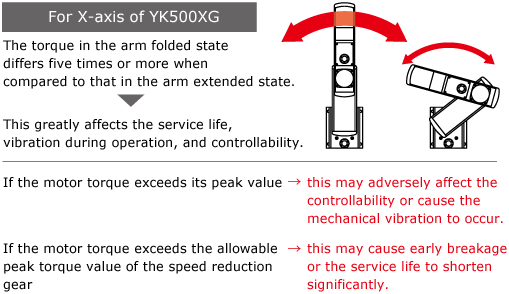
Note.A motor torque that exceeds the peak value will cause bad effects on robot controllability and cause mechanical vibration. Also, exceeding the speed reducer allowable peak torque value will cause early stage robot breakdowns and lead to a drastic drop in the robot service life span.
09. Hollow shaft and tool flange options are selectable
Useful options include a hollow shaft for easy wiring to the tip tool and a tool flange for tool clamping.
* YK250XG/YK350XG/YK400XG/YK500XGL/YK600XGL
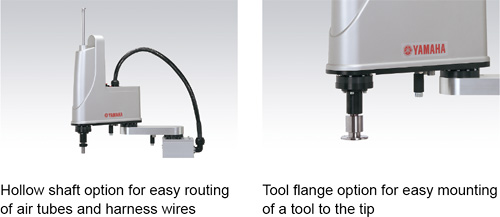
10. History of 30 years
The first YAMAHA robots were SCARA robots. Since the first SCARA robot called "CAME" was produced in 1979, some 30 years of SCARA robot innovations have continually appeared. These SCARA robots have undergone countless modifications in an everchanging marketplace and amassed a hefty record of successful products making them an essential part of the YAMAHA robot lineup.
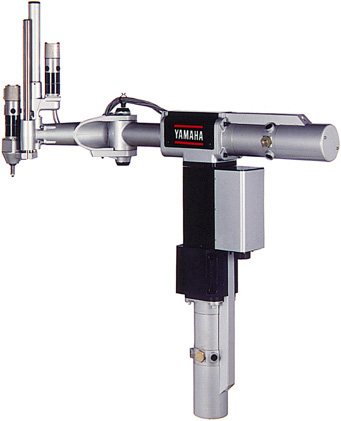

YAMAHA Large type SCARA robots YK-XG
Reach 700-1200 mm | Payload 10-50 kg01 Internal structure achieving the high-rigidity and high-accuracy.

02 Completely beltless structure
A totally beltless structure was achieved by using a ZR axis direct coupling structure. This direct drive structure drastically reduces wasted motion. It also maintains high accuracy over a long period of time. It ensure maintenance-free usage for extended periods with no worries about belt breakage, stretching or deterioration with age (feature applies to all XG series models and the YK180X/YK220X).

03 High speed
The standard cycle time is fast of course but the YAMAHA design also stresses tact time in the actual usage region. A drastic improvement in maximum speed was made by changing the gear ratio and maximum motor rpm. This also resulted in a better tact time during long distance movement.

04 Improved maintenance features
The covers on the YAMAHA SCARA robot YK-XG series can be removed from the front or upwards. The cover is separate from the cable so maintenance tasks are easy.
On ordinary robots replacing the grease on the harmonic gear takes a great deal of time and trouble because the gear must be disassembled and position deviations might occur. On YAMAHA SCARA robots however the harmonic gear is the grease-sealed type so no grease replacement is needed (YK-500XG to YK1000XG).
05 Robot R axis inertia moment capacity
SCARA robot performance is not limited to just standard cycle time. Actual work situations include a diverse range of heavy work pieces as well as work with large offsets. Using a low R axis inertia moment in those cases will help drastically cut the cycle time. All YAMAHA SCARA robots have a speed reducer directly coupled to the tip of the rotating axis. The R axis produces an extremely high allowable inertia moment which delivers high speed operation compared to structures where positioning is usually done by a belt after decelerating.

R axis allowable inertia moment : Comparing YK120XG with competitor's models
A large inertia is generated when the offset from the R axis to the load center is large and this can severely restrict the acceleration during operation.
The allowable inertia moment on the YAMAHA XG series is exceedingly large compared to other company SCARA robots in the same class and so can operate at high speed even with a work offset.
Figures when using 1kg load (see view at upper right)


06 Compact
Changing the cable layout made the overall cable height lower than the unit cover.
Also, utilizing a motor with a small overall length and extrusion material base yielded the smallest dimensions among equipment in the same class.

07 Environmentally rugged resolver provides closed loop control
The position detector is a resolver. The resolver has a simple yet strong structure using not electronic components or elements and so has great features such as being extremely tough in harsh environments as well as a low breakdown rate. The resolver structure has none of the detection problems that occur in other detectors such as optical encoders whose electronic components breakdown or suffer from moisture or oil that sticks to the disk. Moreover, mechanical specifications for both absolute and incremental specifications are common to all controllers so one can switch to either absolute or incremental specifications just by setting a parameter.
Also even if the absolute battery is completely worn down, the SCARA can operate on incremental specifications so in the unlikely event of trouble one can feel secure knowing that there will be no need to stop the production line. The backup circuit has been completely renovated and now has a backup period extending to 1 year.
Note. The resolver has a simple structure not using electronic components at all. It is highly resistant to low and high temperatures, impacts, electrical noise, dust particles, oil, etc. and is used in automobiles, trains, and airplanes.
08 Zone control (=Automatically sets the maximum acceleration/deceleration) function
On SCARA robots there is a large difference in the load applied to the motor and the speed reducer depending on whether the robot arm is folded or extended. YAMAHA SCARA robots however can automatically set an optimal maximum acceleration and deceleration using the arm status when starting operation and the arm status when ending operation. This capability means that just entering the initial payload will prevent the robot from exceeding tolerance values for motor peak torque and speed reducer allowable peak torque. So full power can be extracted from the motor whenever needed and a high level of acceleration/deceleration maintained.

Note. A motor torque that exceeds the peak value will cause bad effects on robot controllability and cause mechanical vibration. Also, exceeding the speed reducer allowable peak torque value will cause early stage robot breakdowns and lead to a drastic drop in the robot service life span.
09 Hollow shaft and tool flange options are selectable
Useful options include a hollow shaft for easy wiring to the tip tool and a tool flange for tool clamping.
*YK250XG/YK350XG/YK400XG/YK500XGL/YK600XGL

10 History of 30 years
The first YAMAHA robots were SCARA robots. Since the first SCARA robot called "CAME" was produced in 1979, some 30 years of SCARA robot innovations have continually appeared. These SCARA robots have undergone countless modifications in an everchanging marketplace and amassed a hefty record of successful products making them an essential part of the YAMAHA robot lineup.


YAMAHA Tiny SCARA robots - Extra small
Reach 120-220 mm | Payload 1-5 kgFEATURES:
01. Internal structure achieving the high-rigidity and high-accuracy.

02. Completely beltless structure
A totally beltless structure was achieved by using a ZR axis direct coupling structure. This direct drive structure drastically reduces wasted motion. It also maintains high accuracy over a long period of time. It ensure maintenance-free usage for extended periods with no worries about belt breakage, stretching or deterioration with age (feature applies to all XG series models and the YK180X/YK220X).

03. High Speed
The standard cycle time is fast of course but the YAMAHA design also stresses tact time in the actual usage region. A drastic improvement in maximum speed was made by changing the gear ratio and maximum motor rpm. This also resulted in a better tact time during long distance movement.

04. Improved maintenance features
The covers on the YAMAHA SCARA robot YK-XG series can be removed from the front or upwards. The cover is separate from the cable so maintenance tasks are easy.
On ordinary robots replacing the grease on the harmonic gear takes a great deal of time and trouble because the gear must be disassembled and position deviations might occur. On YAMAHA SCARA robots however the harmonic gear is the grease-sealed type so no grease replacement is needed (YK-500XG to YK1000XG).
05. Robot R axis inertia moment capacity
SCARA robot performance is not limited to just standard cycle time. Actual work situations include a diverse range of heavy work pieces as well as work with large offsets. Using a low R axis inertia moment in those cases will help drastically cut the cycle time. All YAMAHA SCARA robots have a speed reducer directly coupled to the tip of the rotating axis. The R axis produces an extremely high allowable inertia moment which delivers high speed operation compared to structures where positioning is usually done by a belt after decelerating.

R axis allowable inertia moment : Comparing YK120XG with competitor's models
A large inertia is generated when the offset from the R axis to the load center is large and this can severely restrict the acceleration during operation.
The allowable inertia moment on the YAMAHA XG series is exceedingly large compared to other company SCARA robots in the same class and so can operate at high speed even with a work offset.


06. Compact
Changing the cable layout made the overall cable height lower than the unit cover.
Also, utilizing a motor with a small overall length and extrusion material base yielded the smallest dimensions among equipment in the same class.

07. Environmentally rugged resolver provides closed loop control
The position detector is a resolver. The resolver has a simple yet strong structure using not electronic components or elements and so has great features such as being extremely tough in harsh environments as well as a low breakdown rate. The resolver structure has none of the detection problems that occur in other detectors such as optical encoders whose electronic components breakdown or suffer from moisture or oil that sticks to the disk. Moreover, mechanical specifications for both absolute and incremental specifications are common to all controllers so one can switch to either absolute or incremental specifications just by setting a parameter.
Also even if the absolute battery is completely worn down, the SCARA can operate on incremental specifications so in the unlikely event of trouble one can feel secure knowing that there will be no need to stop the production line. The backup circuit has been completely renovated and now has a backup period extending to 1 year.
Note. The resolver has a simple structure not using electronic components at all. It is highly resistant to low and high temperatures, impacts, electrical noise, dust particles, oil, etc. and is used in automobiles, trains, and airplanes.
08. Zone control (=Automatically sets the maximum acceleration/deceleration) function
On SCARA robots there is a large difference in the load applied to the motor and the speed reducer depending on whether the robot arm is folded or extended. YAMAHA SCARA robots however can automatically set an optimal maximum acceleration and deceleration using the arm status when starting operation and the arm status when ending operation. This capability means that just entering the initial payload will prevent the robot from exceeding tolerance values for motor peak torque and speed reducer allowable peak torque. So full power can be extracted from the motor whenever needed and a high level of acceleration/deceleration maintained.

Note.A motor torque that exceeds the peak value will cause bad effects on robot controllability and cause mechanical vibration. Also, exceeding the speed reducer allowable peak torque value will cause early stage robot breakdowns and lead to a drastic drop in the robot service life span.
09. Hollow shaft and tool flange options are selectable
Useful options include a hollow shaft for easy wiring to the tip tool and a tool flange for tool clamping.
* YK250XG/YK350XG/YK400XG/YK500XGL/YK600XGL

10. History of 30 years
The first YAMAHA robots were SCARA robots. Since the first SCARA robot called "CAME" was produced in 1979, some 30 years of SCARA robot innovations have continually appeared. These SCARA robots have undergone countless modifications in an everchanging marketplace and amassed a hefty record of successful products making them an essential part of the YAMAHA robot lineup.


YAMAHA Orbit type YK350TW/YK500TW
Reach 350-500 mm | Payload 4-5 kgResolves the shortcomings of previous SCARA and parallel-link robots. Offers both superior positioning accuracy and high speed. YAMAHA'S Next-Generation SCARA Robot: The YK-TW Omnidirectional
01 User: We want a smaller equipment footprint. Layout design freedom
The YK-TW can move anywhere through the full 1000 mm* downward range.
Featuring a ceiling-mount configuration with a wide arm rotation angle, the YK-TW can access any point within the full 1000 mm downward range. This eliminates all motion-related restrictions with regard to pallet and conveyor placement operations, while dramatically reducing the equipment footprint.
* Applies to the YK500TW


Underpass motionOptimize use of the space right below the main unit




Improvement of productivity
The standard cycle time for moving 1-kg load horizontally 300 mm and up/down 25 mm is shortened by approximately 36 % compared to existing YAMAHA models.
* Measurement may vary depending on conditions.

02 User: We want a higher quality assembly system. Higher quality
The YK-TW offers a repeated positioning accuracy of +/-0.01 mm* (XY axes).
This is a much higher repeated positioning accuracy than that offered by a parallel-link robot. This was accomplished by optimizing the robot's weight balance through an extensive re-design of its internal construction. The lightweight yet highly rigid arm has also been fitted with optimally tuned motors to enable high accuracy positioning.
* Applies to the YK350TW


03 User: We need to reduce our tact times. Higher productivity
The YK-TW offers a standard cycle time of 0.29 secs*
The Y-axis (arm 2) passes beneath the X-axis (arm 1) and it has a horizontal articulated structure, allowing it to move along the optimal path between points. Moreover, the optimized weight balance of the internal components reduces the cycle time by 36 % as compared to previous models.
* Applies to the YK500TW

The standard cycle time for moving a 1-kg load horizontally 300 mm and up/down 25 mm is shortened by approx. 36 % compared to previous YAMAHA models.
04 User: We need to move heavy workpieces at high speeds. Suitable for a wide range of applications
The YK-TW can handle workpieces weighing up to 5 kg.
Handles loads up to 5 kg. Also accommodates arm-end tools which tend to be heavy, making it highly adaptable to various applications.
05 User: We want to reduce the height of our equipment. Smaller equipment footprint
The YK-TW offers both a low height and a small footprint.
The YK-TW height is only 392 mm. This compact size enables more freedom in the equipment layout design.

06 User: Parallel-link robots require large frames which complicate installation… Easy installation
The YK-TW has a total height of only 392 mm, and weighs only 27 kg*. Due to its low inertia, a sturdy frame is not required.
* Applies to the YK500TW

An optional dedicated installation frame is available for the YK-TW. For details, contact a YAMAHA sales representative.
07 Preparing an installation stand is too much bother. A dedicated stand is available
Setup can be simplified
As an option, we provide a dedicated installation stand for the YK-TW.* There's no need to calculate strength, so setup can be simplified.
* Contact Yamaha for details on dimensions and price.

08 User: Operating our equipment in stringent environments is worrisome… Environment resistant
The YK-TW features the same type of resolver as those used in hybrid automobiles and aircraft.
This resolver is a magnetic position sensor. It features a simple construction with no electronic or optical parts, making it far less susceptible to failure than conventional optical encoders. It is this superior environment resistance and low failure rate that makes it reliable enough for use in many fields such as hybrid automobiles and aircraft, etc., where reliability is essential.

YAMAHA Medium type SCARA robots YK-XG
Reach 500-600 mm | Payload 5-20 kgCompletely beltless structure with the tip rotation axis directly connected to the speed reduction gear.
This ensures high-accuracy, high-speed, excellent maintenance ability, and amazing tolerable moment of inertia.
01 Internal structure achieving the high-rigidity and high-accuracy.

02 Completely beltless structure
A totally beltless structure was achieved by using a ZR axis direct coupling structure. This direct drive structure drastically reduces wasted motion. It also maintains high accuracy over a long period of time. It ensure maintenance-free usage for extended periods with no worries about belt breakage, stretching or deterioration with age (feature applies to all XG series models and the YK180X/YK220X).

03 High speed
The standard cycle time is fast of course but the YAMAHA design also stresses tact time in the actual usage region. A drastic improvement in maximum speed was made by changing the gear ratio and maximum motor rpm. This also resulted in a better tact time during long distance movement.

04 Improved maintenance features
The covers on the YAMAHA SCARA robot YK-XG series can be removed from the front or upwards. The cover is separate from the cable so maintenance tasks are easy.
On ordinary robots replacing the grease on the harmonic gear takes a great deal of time and trouble because the gear must be disassembled and position deviations might occur. On YAMAHA SCARA robots however the harmonic gear is the grease-sealed type so no grease replacement is needed (YK-500XG to YK1000XG).
05 Robot R axis inertia moment capacity
SCARA robot performance is not limited to just standard cycle time. Actual work situations include a diverse range of heavy work pieces as well as work with large offsets. Using a low R axis inertia moment in those cases will help drastically cut the cycle time. All YAMAHA SCARA robots have a speed reducer directly coupled to the tip of the rotating axis. The R axis produces an extremely high allowable inertia moment which delivers high speed operation compared to structures where positioning is usually done by a belt after decelerating.

R axis allowable inertia moment : Comparing YK120XG with competitor's models
A large inertia is generated when the offset from the R axis to the load center is large and this can severely restrict the acceleration during operation.
The allowable inertia moment on the YAMAHA XG series is exceedingly large compared to other company SCARA robots in the same class and so can operate at high speed even with a work offset.
Figures when using 1kg load (see view at upper right)


06 Compact
Changing the cable layout made the overall cable height lower than the unit cover.
Also, utilizing a motor with a small overall length and extrusion material base yielded the smallest dimensions among equipment in the same class.

07 Environmentally rugged resolver provides closed loop control
The position detector is a resolver. The resolver has a simple yet strong structure using not electronic components or elements and so has great features such as being extremely tough in harsh environments as well as a low breakdown rate. The resolver structure has none of the detection problems that occur in other detectors such as optical encoders whose electronic components breakdown or suffer from moisture or oil that sticks to the disk. Moreover, mechanical specifications for both absolute and incremental specifications are common to all controllers so one can switch to either absolute or incremental specifications just by setting a parameter.
Also even if the absolute battery is completely worn down, the SCARA can operate on incremental specifications so in the unlikely event of trouble one can feel secure knowing that there will be no need to stop the production line. The backup circuit has been completely renovated and now has a backup period extending to 1 year.
Note. The resolver has a simple structure not using electronic components at all. It is highly resistant to low and high temperatures, impacts, electrical noise, dust particles, oil, etc. and is used in automobiles, trains, and airplanes.
08 Zone control (=Automatically sets the maximum acceleration/deceleration) function
On SCARA robots there is a large difference in the load applied to the motor and the speed reducer depending on whether the robot arm is folded or extended. YAMAHA SCARA robots however can automatically set an optimal maximum acceleration and deceleration using the arm status when starting operation and the arm status when ending operation. This capability means that just entering the initial payload will prevent the robot from exceeding tolerance values for motor peak torque and speed reducer allowable peak torque. So full power can be extracted from the motor whenever needed and a high level of acceleration/deceleration maintained.

Note.A motor torque that exceeds the peak value will cause bad effects on robot controllability and cause mechanical vibration. Also, exceeding the speed reducer allowable peak torque value will cause early stage robot breakdowns and lead to a drastic drop in the robot service life span.
09 Hollow shaft and tool flange options are selectable
Useful options include a hollow shaft for easy wiring to the tip tool and a tool flange for tool clamping.
*YK250XG/YK350XG/YK400XG/YK500XGL/YK600XGL

10 History of 30 years
The first YAMAHA robots were SCARA robots. Since the first SCARA robot called "CAME" was produced in 1979, some 30 years of SCARA robot innovations have continually appeared. These SCARA robots have undergone countless modifications in an everchanging marketplace and amassed a hefty record of successful products making them an essential part of the YAMAHA robot lineup.


YAMAHA Wall-mount and inverse type SCARA robots
Reach 300-1000 mm | Payload 3-20 kgAs the ceiling installation or the wall installation is used, the robot installation space that could not be used conventionally can be utilized efficiently.
01 Hanging type is renewed. Completely beltless structure and high rigidity
As the conventional hanging type is changed to the wall mount type, the flexibility of the system design is improved. The production equipment can be downsized. Additionally, as an inverse type that allows upward operation is also added to the product lineup, the flexibility of the working direction is widened. Furthermore, use of a completely beltless structure achieves a maximum payload of 20 kg and a R-axis tolerable moment of inertia of 1 kgm2* that are the top in the class. A large hand can also be installed. So, this robot is suitable for heavy load work.
*YK700XGS to YK1000XGS

02 Internal structure achieving the high-rigidity and high-accuracy.

03 Completely beltless structure
A totally beltless structure was achieved by using a ZR axis direct coupling structure. This direct drive structure drastically reduces wasted motion. It also maintains high accuracy over a long period of time. It ensure maintenance-free usage for extended periods with no worries about belt breakage, stretching or deterioration with age (feature applies to all XG series models and the YK180X/YK220X).

04 High speed
The standard cycle time is fast of course but the YAMAHA design also stresses tact time in the actual usage region. A drastic improvement in maximum speed was made by changing the gear ratio and maximum motor rpm. This also resulted in a better tact time during long distance movement.

05 Improved maintenance features
The covers on the YAMAHA SCARA robot YK-XG series can be removed from the front or upwards. The cover is separate from the cable so maintenance tasks are easy.
On ordinary robots replacing the grease on the harmonic gear takes a great deal of time and trouble because the gear must be disassembled and position deviations might occur. On YAMAHA SCARA robots however the harmonic gear is the grease-sealed type so no grease replacement is needed (YK-500XG to YK1000XG).
06 Robot R axis inertia moment capacity
SCARA robot performance is not limited to just standard cycle time. Actual work situations include a diverse range of heavy work pieces as well as work with large offsets. Using a low R axis inertia moment in those cases will help drastically cut the cycle time. All YAMAHA SCARA robots have a speed reducer directly coupled to the tip of the rotating axis. The R axis produces an extremely high allowable inertia moment which delivers high speed operation compared to structures where positioning is usually done by a belt after decelerating.

R axis allowable inertia moment : Comparing YK120XG with competitor's models
A large inertia is generated when the offset from the R axis to the load center is large and this can severely restrict the acceleration during operation.
The allowable inertia moment on the YAMAHA XG series is exceedingly large compared to other company SCARA robots in the same class and so can operate at high speed even with a work offset.
Figures when using 1kg load (see view at upper right)


07 Compact
Changing the cable layout made the overall cable height lower than the unit cover.
Also, utilizing a motor with a small overall length and extrusion material base yielded the smallest dimensions among equipment in the same class.

08 Environmentally rugged resolver provides closed loop control
The position detector is a resolver. The resolver has a simple yet strong structure using not electronic components or elements and so has great features such as being extremely tough in harsh environments as well as a low breakdown rate. The resolver structure has none of the detection problems that occur in other detectors such as optical encoders whose electronic components breakdown or suffer from moisture or oil that sticks to the disk. Moreover, mechanical specifications for both absolute and incremental specifications are common to all controllers so one can switch to either absolute or incremental specifications just by setting a parameter.
Also even if the absolute battery is completely worn down, the SCARA can operate on incremental specifications so in the unlikely event of trouble one can feel secure knowing that there will be no need to stop the production line. The backup circuit has been completely renovated and now has a backup period extending to 1 year.
Note. The resolver has a simple structure not using electronic components at all. It is highly resistant to low and high temperatures, impacts, electrical noise, dust particles, oil, etc. and is used in automobiles, trains, and airplanes.
09 Zone control (=Automatically sets the maximum acceleration/deceleration) function
On SCARA robots there is a large difference in the load applied to the motor and the speed reducer depending on whether the robot arm is folded or extended. YAMAHA SCARA robots however can automatically set an optimal maximum acceleration and deceleration using the arm status when starting operation and the arm status when ending operation. This capability means that just entering the initial payload will prevent the robot from exceeding tolerance values for motor peak torque and speed reducer allowable peak torque. So full power can be extracted from the motor whenever needed and a high level of acceleration/deceleration maintained.

Note.A motor torque that exceeds the peak value will cause bad effects on robot controllability and cause mechanical vibration. Also, exceeding the speed reducer allowable peak torque value will cause early stage robot breakdowns and lead to a drastic drop in the robot service life span.
10 Hollow shaft and tool flange options are selectable
Useful options include a hollow shaft for easy wiring to the tip tool and a tool flange for tool clamping.
*YK250XG/YK350XG/YK400XG/YK500XGL/YK600XGL

11 History of 30 years
The first YAMAHA robots were SCARA robots. Since the first SCARA robot called "CAME" was produced in 1979, some 30 years of SCARA robot innovations have continually appeared. These SCARA robots have undergone countless modifications in an everchanging marketplace and amassed a hefty record of successful products making them an essential part of the YAMAHA robot lineup.


Epson G3 SCARA Robots - 350mm
Reach 150-350 mm | Repeatability 0mm | Payload 1-3 kgThe G3 SCARA Robot is a compact, powerful and low cost robot. Best in class cycle time and precision, tabletop, ceiling and wall mount models. A unique curved arm option, ISO clean & ESD compliant models.
The G3 SCARA Robot is also available in 250mm and 300mm arm lengths
Epson G3 robots lead the industry with best in class cycle time, precision and motion range. With over 30 models available in sizes from 250-350mm, Epson G3 robots are the robot of choice for high precision, high speed applications where performance AND low cost are required. G3 SCARA robots are ideal for applications such as hard drive assembly, lab automation, electronics assembly, medical device assembly, photonics, semiconductor, telecommunications, solar, and many others.
Unique to the G-Series, is the new curved arm option which allows G3 arms to be purchased as right or left curved models to maximize work envelope usage while maintaining small workspace usage overall. G3 arms are available in 250, 300 and 350mm arm lengths and come with 150mm (120 clean) Z-Axis lengths. They are also available in table top, wall or ceiling mount configurations as well as Clean/ESD configurations. Lots of choices. A lot more Power of Choice.

Epson G6 SCARA Robots - 650mm
Reach 180-650 mm | Repeatability 0mm | Payload 3-6 kgHigh Speed. High Variety
Best in Class Motion Range
Tabletop, Ceiling and Wall Mount Models
ISO Clean & ESD Compliant Models
Also available in 450mm and 550mm arm lengths
Epson G6 SCARA robots are perfect for applications requiring high speed and/or high precision such as mechanical or electrical assembly, pick and place, kitting, dispensing and much more. With applications running in demanding industries such as Automotive, Medical, Semiconductor, Food, Pharmaceutical, Hard Drive, Consumer, and many others, Epson G6 SCARA's are the robot of choice. G6 SCARA arms are available in 450, 550 and 650mm lengths with either 180 (150 clean) or 330 (300 clean) Z-Axis lengths. They are also available in table top, wall or ceiling mount configurations. Clean/ESD and Washdown models are also available in all 3 core arm lengths. That makes for a lot of choices to make sure you get the right robot for your next application.
Unique to the G6 is our new Max-E envelope design. With Max-E, Epson G6-55x robots are now able to do jobs that previously required 600mm arms. Smaller footprints are the key and that translates to less factory space requirements and less overall factory costs.

Epson G20 SCARA Robots - 1000mm
Reach 180-1000 mm | Repeatability 0mm | Payload 10-20 kgLong Reach, Heavy Payloads, and High Performance
Super Heavy Payloads with High Performance
Tabletop, Ceiling and Wall Mount Models
ISO Clean & ESD Compliant Models
IP54 and IP65 Washdown/Dustproof Models
Also available in 850mm arm length
Epson G20 SCARA robots are the heavyweight champion when it comes to SCARA robots performance under heavy payloads. With Epson's new high rigidity arm design, G20 robots can handle up to 20Kg payloads at high speeds. Most robots available today that promise higher payloads do so with extremely reduced cycle times and poor duty cycles. Epson G20 SCARA robots were designed for heavy payloads while running 24/7 at high speeds. G20 SCARA's are perfect for higher payload applications such as machine load/unload, palletizing, mechanical assembly, pick and place applications, food handling and hundreds of other applications. With applications running in demanding industries such as Automotive, Medical, Semi Conductor, Food, Pharmaceutical, Consumer, and many others, Epson G20 SCARA's deliver the high performance required for todays demanding applications when other SCARA robots can't.
G20 SCARA arms are available in 850 and 1000mm lengths with either 180 (150 clean) or 420 (390 clean) Z-Axis lengths. They are also available in table top , wall or ceiling mount configurations. Clean/ESD, Washdown and Dustproof models are also available. That makes for a lot of choices to make sure you get the right robot for your next application.
G20 SCARA robots incorporate the new Max-E work envelope design. With Max-E, Epson G-Series SCARA robots are able to do jobs that previously required 50mm or more of additional reach. Smaller footprints are what make this happen and that translates to less factory space requirements and less overall factory costs.

Epson G20 SCARA Robots - 850mm
Reach 180-850 mm | Repeatability 0mm | Payload 10-20 kgLong Reach, Heavy Payloads, and High Performance
Super Heavy Payloads with High Performance
Tabletop, Ceiling and Wall Mount Models
ISO Clean & ESD Compliant Models
IP54 and IP65 Washdown/Dustproof Models
Also available in 1000mm arm length
Epson G20 SCARA robots are the heavyweight champion when it comes to SCARA robots performance under heavy payloads. With Epson's new high rigidity arm design, G20 robots can handle up to 20Kg payloads at high speeds. Most robots available today that promise higher payloads do so with extremely reduced cycle times and poor duty cycles. Epson G20 SCARA robots were designed for heavy payloads while running 24/7 at high speeds. G20 SCARA's are perfect for higher payload applications such as machine load/unload, palletizing, mechanical assembly, pick and place applications, food handling and hundreds of other applications. With applications running in demanding industries such as Automotive, Medical, Semi Conductor, Food, Pharmaceutical, Consumer, and many others, Epson G20 SCARA's deliver the high performance required for todays demanding applications when other SCARA robots can't.
G20 SCARA arms are available in 850 and 1000mm lengths with either 180 (150 clean) or 420 (390 clean) Z-Axis lengths. They are also available in table top , wall or ceiling mount configurations. Clean/ESD, Washdown and Dustproof models are also available. That makes for a lot of choices to make sure you get the right robot for your next application.
G20 SCARA robots incorporate the new Max-E work envelope design. With Max-E, Epson G-Series SCARA robots are able to do jobs that previously required 50mm or more of additional reach. Smaller footprints are what make this happen and that translates to less factory space requirements and less overall factory costs.


